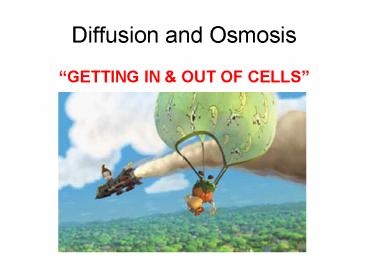Diffusion and Osmosis - PowerPoint PPT Presentation
1 / 12
Title:
Diffusion and Osmosis
Description:
Diffusion and Osmosis GETTING IN & OUT OF CELLS Passive Transport Cell membranes help organisms maintain homeostasis by controlling what substances may enter or ... – PowerPoint PPT presentation
Number of Views:83
Avg rating:3.0/5.0
Title: Diffusion and Osmosis
1
Diffusion and Osmosis
- GETTING IN OUT OF CELLS
2
Passive Transport
- Cell membranes help organisms maintain
homeostasis by controlling what substances may
enter or leave cells. Some substances can cross
the cell membrane without any input of energy by
the cell. The movement of such substances across
the membrane is known as passive transport.
3
Passive Transport
- Examples
- Diffusion
- Osmosis
- Facilitated diffusion
4
Methods of Transport
- Diffusion the random movement of particles of a
solute from an area of higher concentration to an
area of lower concentration. - Particles always move with (down) a concentration
gradient (the difference in concentrations across
a membrane). - Passive transport.
5
Molecules move from higher to lower concentration
6
Diffusion
- Diffusion stops at equilibrium (when the
concentrations across a membrane are equal). - The movement of molecules continues at
equilibrium but the of molecules moving across
the membrane remains the same.
7
Osmosis
- the diffusion of water through a selectively
permeable membrane. - Passive transport
- Water molecules move from a higher concentration
OF WATER to a lower concentration OF WATER. - Water will move to where there is a greater
amount of solute because there is less water
there.
8
(No Transcript)
9
Isotonic solutions the concentration of solute
inside and outside of the cell is the same.
- Osmosis does not occur because equilibrium has
already been reached.
10
Hypotonic solutions the concentration of solute
is lower outside the cell than inside the cell.
- Have more water outside the cell so water moves
into the cell - Causes an increase in pressure inside the cell
called turgor pressure (plants) or osmotic
pressure (animals). - Increase in pressure in animal cells causes them
to swell or even burst gives plant cells shape
and support.
11
Hypertonic solutions the concentration of solute
is higher outside the cell than inside the cell.
- Have more water inside the cell so water moves
out of the cell - Causes a drop in turgor or osmotic pressure
called plasmolysis. - Plasmolysis causes animal cells to shrivel up and
plants to wilt.
12
The effect of osmosis in a) hypertonic solution
b) isotonic solution c) hypotonic solution.































